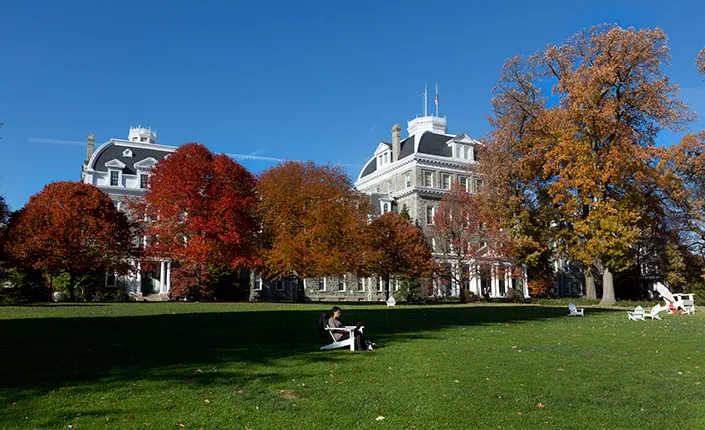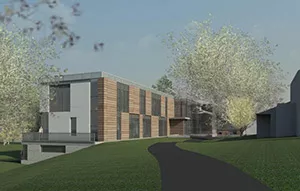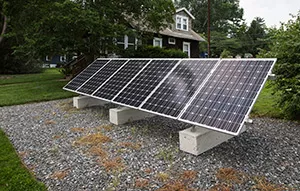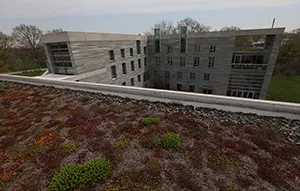The Greenprint

Water. Waste. Energy use. New building construction and renovation. Thoughtful conversations about these and other issues, as well as how to minimize their environmental impact, have long been held on campus. But a clear way to connect all of them together had proven elusive – until now.
In September, the Board of Managers adopted a sustainability framework that does just that. In keeping with Swarthmore’s values and long tradition of stewarding the environment, it prescribes a green approach to sustainable buildings, stormwater management, and the reduction of carbon and energy use. Read an executive summary [pdf]; the full report is available on Slideshare.
“The Board is fully committed to increasing and supporting the College’s sustainable practices,” says Board Chair Tom Spock ’78. “Our plan is to build upon the important environmental efforts that are already underway and expand upon them.”
“This document reflects the values and commitments of the entire institution,” says Valerie Smith, president. “The framework provides an invaluable guide for future projects and for the stewardship of the College's resources."
“One of the things that makes this place special is that we’ll jump in with both feet,” says Stu Hain, vice president for facilities and capital projects. “This was a huge commitment by the Board of not just time, but financial resources to support sustainability goals.”

The planned Whittier Place Academic Building will be one of the first to be built in accordance to the new Sustainability Framework. Construction is expected to begin next year for a Spring 2017 opening.
For Ralph Thayer, director of maintenance, it represents a “sea change” in thinking.
“The framework demanded a commitment from the administration and the Board,” he says, “to examine our buildings and grounds and make decisions based on their environmental impact, not just the cost of construction.”
The framework organizes the College’s sustainability initiatives to establish goals and prioritize funding for landscapes, buildings, and operations. It outlines standards, implementation plans, protocols for measuring progress, and the next steps to take to advance the College’s commitments to sustainability and climate protection as it relates to capital projects and facilities operations.
“As the College moves forward on multiple building projects, it becomes ever more urgent that we increase our commitment to climate neutrality,” says Betsy Bolton, professor of English literature and a Crum Woods Stewardship committee member. “This framework is a deeply considered, densely informative, consensus-affirmed step in that direction.”
Among the specific goals outlined in the framework:
- Increasing stormwater management techniques above those required by law and improving the health of the Crum Creek watershed.
- Achieving 23-40 percent reduction over projected 2035 carbon emissions and measuring the use of electricity, steam, chilled water, and natural gas in all campus buildings.
- Achieving net-zero carbon in all new building construction, designing all new construction to 50 percent better than widely used energy standards for buildings, and achieving specific efficiency targets for all major projects.
- Installing a minimum of 45 percent native/adaptive vegetation and replacing turf where possible with native/adaptive plantings; installing LED exterior light fixtures; reducing waste associated with projects.

This spring, students installed solar panels and an electric charging station on campus.
The origins of the framework trace back to the social responsibility committee of the Board, from which students proposed creating a green design standard for Swarthmore within the context of LEED certification. Other members of the community felt LEED, which recognizes best-in-class building strategies and practices, wasn’t enough — and urged that Swarthmore needed guidelines tailored to its particular goals and resources.
Among the College’s highest priorities is reducing how much carbon it puts into the air, says Hain, citing its American Colleges and University Presidents Climate Commitment to achieve carbon neutrality by 2035. Another is managing the use of water on campus and water that runs off of campus into local streams and rivers.
These discussions then dovetailed with plans for the largest building in Swarthmore’s history: the Biology, Engineering, and Psychology (BEP) building.
“We realized that not setting a standard for that building would be a real missed opportunity,” says Hain.
With colleagues, Hain pushed to develop a sustainability standard in concert with developing the schemes and concepts of BEP. Fortunately, he says, the project’s designer and engineers had a team of professionals with experience on Swarthmore’s campus and with cutting-edge sustainability efforts. The College, with the blessing of the Board, also had a seasoned team of people more than happy to work on a standard during the 2014-15 academic year.
Both teams studied the campus, identifying the watersheds doing the most damage and the buildings wasting the most energy, along with strategies to improve them.

The College's more than 60,000 square feet of green roofs absorb rainwater while also providing natural habitat.
Our goal had been LEED Silver status,” Hain says, “but this framework will get us to an even higher standard, the equivalent of LEED Platinum if we do it right.”
The document itself will continue to evolve.
“There will definitely be ongoing conversations,” says Jan Semler, director of capital planning and project management, “and a lot of new ideas and perspectives could be applied to our goals.”
Sustainability Coordinator Melissa Tier ’14, for one, is excited. “This framework will be so visible,” she says. “I want this process to be very transparent and for our community to join together to work on the next steps together.”
The College’s new sustainability director, Aurora Winslade, arrives next month. First on her list? Putting the framework into action.
“The Framework charts a clear path forward for the College’s operational sustainability efforts,” she says. “It will take significant effort and require everyone to work together to implement it, but I am confident the results will be worth it.”



